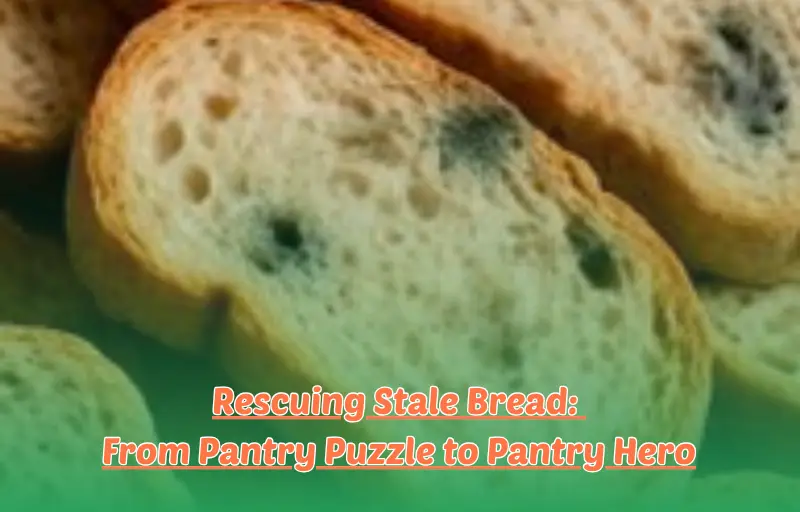We’ve all been there: you reach into the pantry hoping for a soft slice of sandwich bread, only to pull out a loaf that’s as hard as a doorstop. Your mother-in-law chides you for letting it go to waste, but you shudder at the thought of chewing on a brick. Before you toss that loaf—and waste water, grain, and all the resources baked into it—let’s explore why bread goes stale, how to tell if it’s truly past saving, and a handful of creative, delicious rescues that will have you looking forward to a pantry treasure hunt rather than a cooking disaster.

What “Stale” Really Means
When bread “stales,” it’s not spoiled; it’s simply undergone retrogradation, a process in which the starch molecules shift and expel moisture, leaving the crumb dry and firm. This textural change happens within days of baking—especially if the loaf isn’t tightly wrapped or stored in a dry container. Crucially, stale ≠ unsafe. Unless you spot fuzzy mold (green, black, or white specks) or detect a sour smell, stale bread remains edible.
Safety First: Check Before You Chew
- Visual inspection: Look for any fuzzy growth. Mold can lurk beneath the crust, so examine slices carefully.
- Sniff test: Fresh bread has a neutral or slightly yeasty aroma; anything sour or musty signals spoilage.
- Texture check: Dry and hard is fine; slimy or sticky means bacteria have taken hold.
If it passes these tests, you’re clear to move on to repurposing. Throwing away still-safe bread contributes to landfill methane—so read on for zero-waste strategies.
Quick Rehydration Hack
Restore moisture in under 15 minutes:
- Preheat your oven to 350 °F (175 °C).
- Mist the stale loaf lightly with water (or rub with a damp cloth).
- Wrap it in foil and bake for 8–10 minutes.
- Unwrap and bake 2–3 more minutes to crisp the crust.
This simple trick plumps up the crumb and delivers almost-fresh bread for sandwiches or toasting.
Zero-Waste Recipes for Stale Bread
- Crunchy Croutons & Breadcrumbs
- Croutons: Cube the bread, toss with olive oil, garlic powder, and herbs, then bake at 375 °F until golden. Store in an airtight jar for salads and soups.
- Breadcrumbs: Pulse cubes in a food processor until coarse crumbs form; toast briefly in a skillet. Keep them on hand for meatballs, breading, or gratin toppings.
- Savory Strata or Bread Pudding
- Layer cubes in a baking dish with cheese, sautéed vegetables, and herbs. Whisk together eggs, milk (or cream), salt, and pepper, pour over the bread, and bake until puffed and golden. A perfect brunch or side dish.
- French Toast & Pain Perdu
- Whisk eggs with milk, vanilla, and a pinch of salt. Soak thick slices 20–30 seconds per side, then cook in butter until golden. Top with fresh fruit, syrup, or a dusting of powdered sugar.
- Panzanella (Bread Salad)
- Toss toasted bread cubes with ripe tomatoes, cucumbers, red onion, basil, olive oil, and vinegar. Let sit so the bread soaks up the juices—a bright summer salad that celebrates imperfect bread.
- Sweet Bread Pudding
- Cube the bread and layer in a buttered casserole dish. Pour over a mixture of eggs, milk, sugar, vanilla, and cinnamon. Bake until set and serve warm with a drizzle of caramel or a scoop of ice cream.
Beyond Recipes: Creative Uses
- Stuffing or Dressing: Season with sage, thyme, and stock for holiday sides.
- Bread Soup (Ribollita-Style): Simmer with vegetables and beans in broth for a cozy Italian-inspired stew.
- Savory Bread Crust Chips: Brush thin crust pieces with oil, sprinkle with salt and pepper, and bake for homemade “chips.”
Storage Strategies to Prevent Future Waste
- Room-Temperature Storage: Keep your loaf in a bread box or paper bag to allow just enough airflow—avoid plastic, which traps moisture and accelerates mold.
- Freezing: Slice the loaf, wrap in plastic, then foil, and freeze. Pull out individual slices to toast, or thaw whole slices in the oven.
Cultural Inspiration: Global Bread Traditions
- Italy’s Panzanella transforms stale bread into vibrant salads.
- France’s Pain Perdu—literally “lost bread”—elevates leftover baguettes with custard and syrup.
- Latin America’s Torrijas soak slices in milk and sugar before frying, much like French toast.
These time-honored dishes remind us that creativity in the kitchen is the ultimate antidote to waste.
Chef Wisdom: Turning Thrift into Gourmet
Top chefs often celebrate leftover bread as an opportunity. Massimo Bottura’s famous “Oops! I Dropped the Lemon Tart” repurposes broken tart into a layered dessert; his approach to minimizing waste can be applied to stale bread, too. When you shift your perspective from “waste” to “ingredient,” you unlock a world of delicious possibility.
Final Thoughts: Your Pantry, Reimagined
Next time you discover a stale loaf, remember: you’re holding not trash, but the makings of croutons, custards, strata, and more. By giving stale bread a second life, you honor both your household budget and the planet’s resources. So embrace that rock-hard loaf—your taste buds (and your mother-in-law) will thank you.
What’s your favorite way to rescue stale bread? Share your go-to recipe or creative hack in the comments below!
